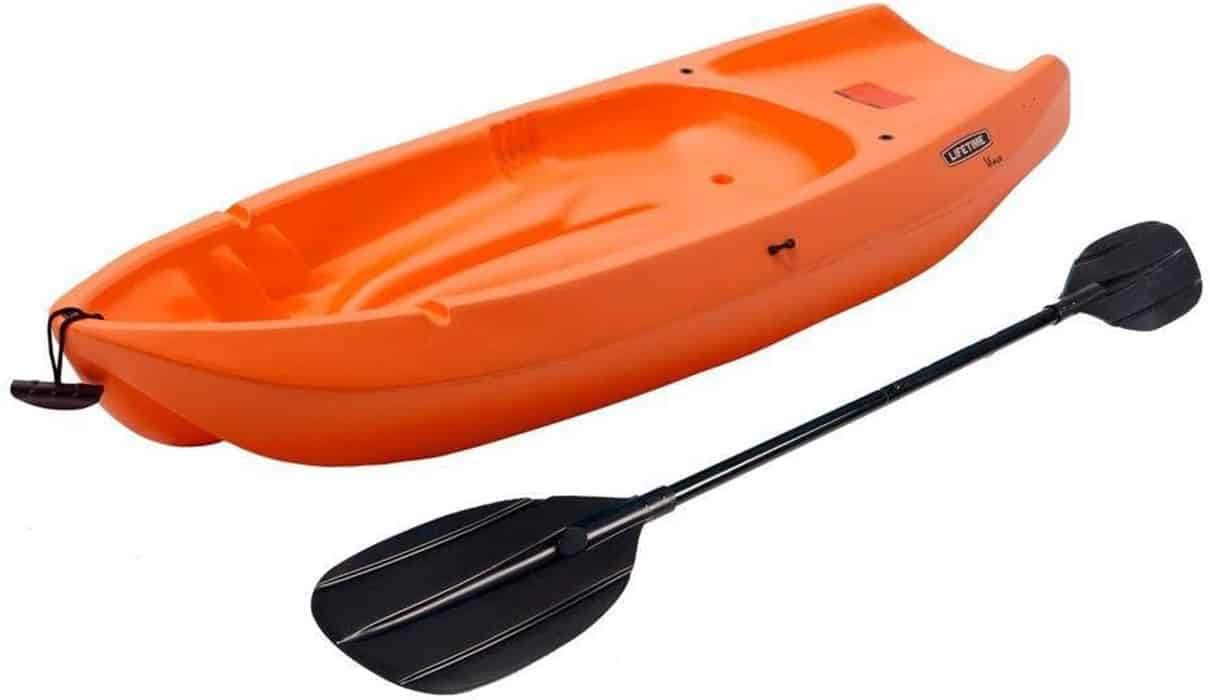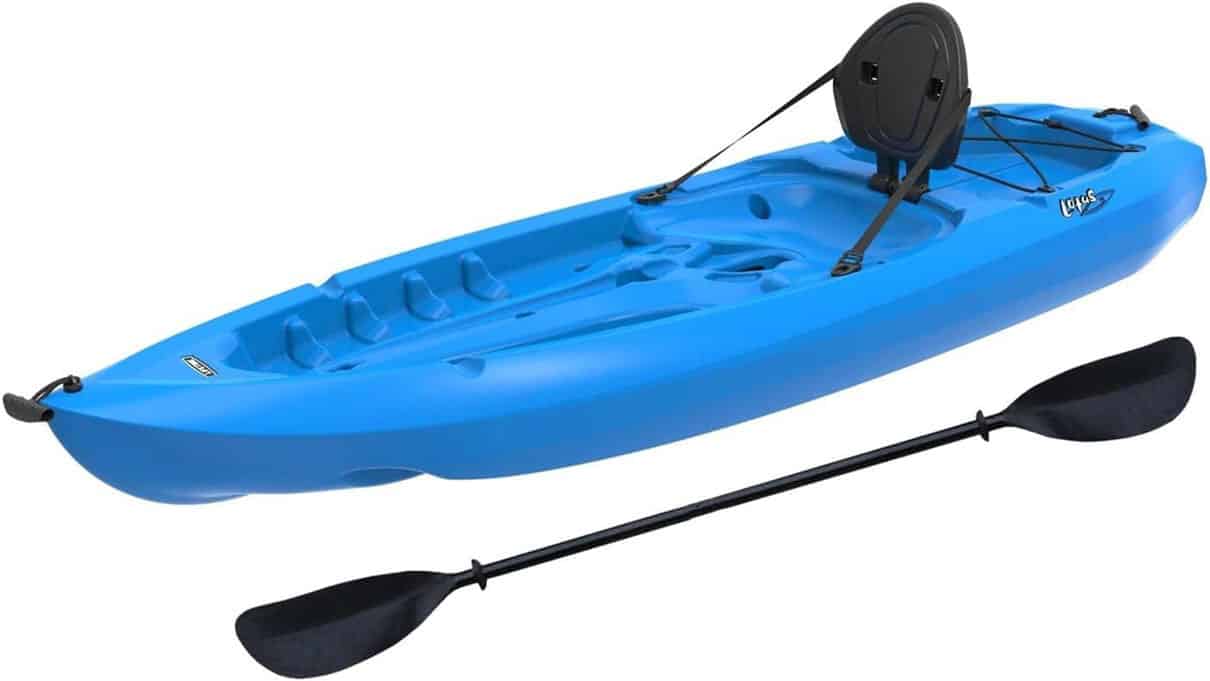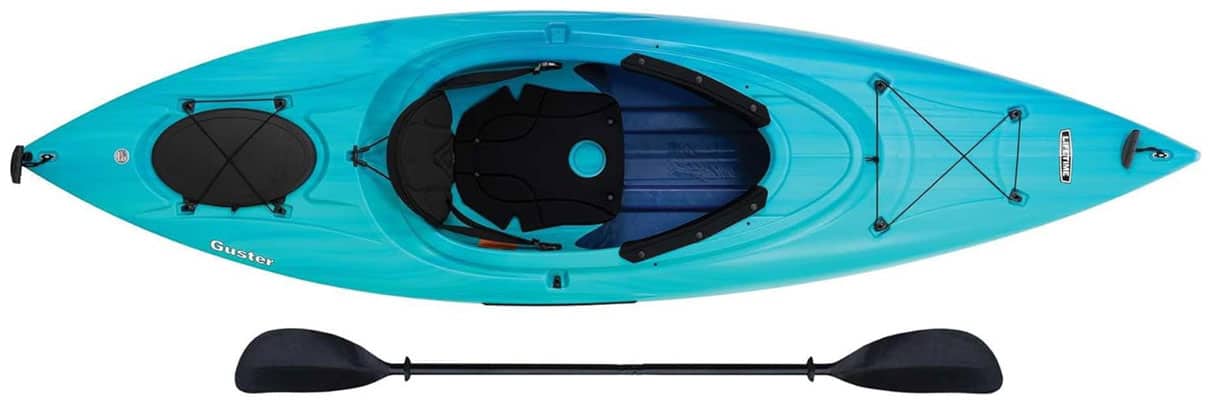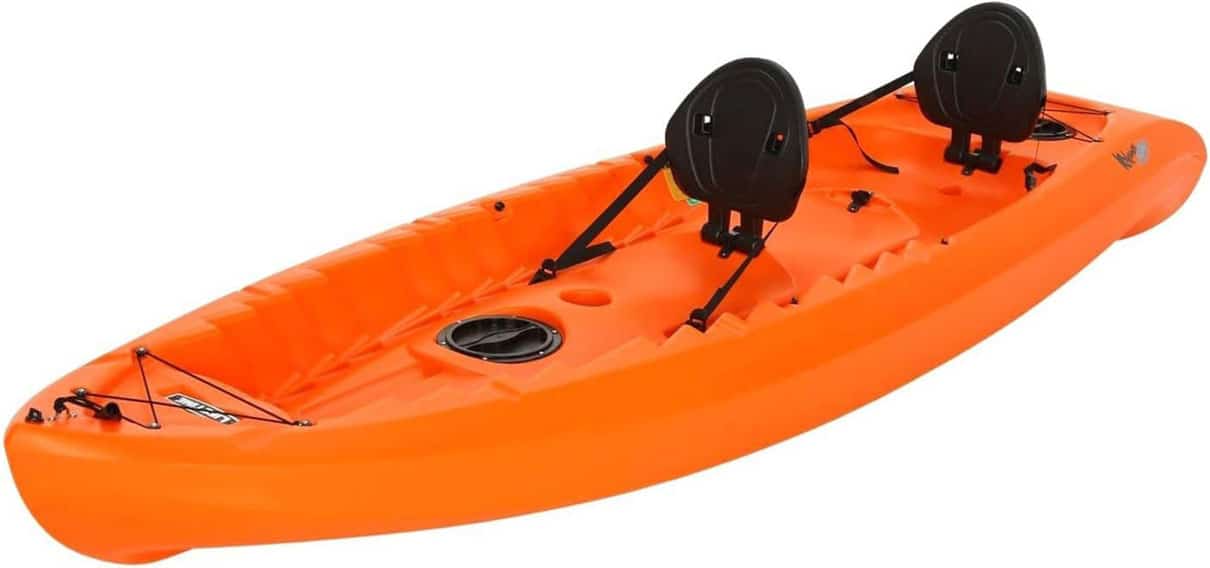Founded in Utah in 1986, Lifetime Products has a long history of sporting goods innovation. The first product they made was basketball nets, and they were a big deal. Lifetime basketball nets featured a quick-adjust system, making the nets easy to raise or lower with just a broom handle. This caught on quickly, and soon every driveway basketball net was a Lifetime.
Today, you’ll see Lifetime nets on courts around the world, but the innovation didn’t stop there. The company grew and expanded their manufacturing to include picnic tables, sporting goods and many other products that require plastic strong enough to withstand the elements at a reasonable price.
When Lifetime Products acquired Emotion Kayaks in 2011, it was a natural transition to paddlesports. The merger combined Emotion’s knowledge of recreational kayak design with Lifetime’s robust plastic manufacturing processes. Lifetime adapted their experience producing high-density polyethylene plastics to producing affordable recreational kayaks that are perfect for beginners.
Lifetime kayaks are great for those who want a stable and reliable kayak without making a hefty investment. Lifetime offers both sit-on-tops and sit-inside kayaks, as well as dedicated fishing and youth kayaks.
Lifetime kayaks are ideal for new kayakers or those who know they want to stay in sheltered waters. They are great for short outings at the local beach, slow-moving river or quiet lake. These plastic kayaks are very affordable, and their sturdy plastic construction requires very little maintenance. With different types to choose from, there are Lifetime kayak options for all body sizes.
Top picks: Lifetime kayaks
Lifetime Tamarack Angler 100
Lifetime Tamarack Angler 100 Specs
Length: 10’0”
Width: 31”
Weight: 51 lbs
Capacity: 275 lbs
MSRP: $629.99 USD
Buy from:
LIFETIME AL’S AMAZON CAMPSAVER
From our review:
“The Lifetime Tamarack Angler 100 is a sit-on-top kayak intended for kayak fishing. It is most suitable for day trips on mild waterways including small lakes, bays and slow moving rivers.
That’s a great start, but is the Lifetime Tamarack Angler 100 fishing kayak ocean capable? In concept, the Tamarack Angler 100 could be used…” [ Read full review ]
Lifetime Wave Youth
Lifetime Wave Youth Specs
Length: 6’0”
Width: 24”
Weight: 18 lbs
Capacity: 130 lbs
MSRP: $235 USD
Buy from:
From our review:
“The Lifetime Wave 60 Youth kayak features outstanding stability—a critical performance feature for parents concerned about their children’s safety. A flat bottom keeps the kayak from feeling tippy at first float; in fact, the Wave 60 Youth is stable enough to be used as a swim platform.
The stern of the kayak is blunt and low to the water to create a swim-up deck for kids to climb aboard. The Lifetime Wave 60 Youth kayak maximum capacity is 130 pounds, and the manufacturer recommends…” [ Read full review ]
Lifetime Payette 98
Lifetime Payette 98 Specs
Length: 9’8”
Width: 30”
Weight: 45 lbs
Capacity: 250 lbs
MSRP: $579.99 USD
Buy from:
Paddle your way to adventure with the Lifetime Payette kayak, a sit-inside kayak designed for stability and control. Whether you want to explore a mountainside lake or venture down a picturesque river, the Payette will take you there in style. The large cockpit with comfortable backrest allow for long paddling adventures and the enclosed storage compartment will let you store your gear while you’re on the water. Enjoy the durability of the UV-protected, impact-resistant construction and the convenience of front and rear T-handles that make transport to and from the water easier than ever. The Lifetime Payette is the perfect kayak to take along on trips with friends or family.
Lifetime Lotus 80
Lifetime Lotus 80 Specs
Length: 8’0”
Width: 30”
Weight: 38 lbs
Capacity: 250 lbs
MSRP: $399.99 USD
Buy from:
The 8 ft. Lifetime Lotus Kayak has a comfortable backrest perfect for long kayaking adventures. Its compact design easily fits inside the average apartment or home closet, and the back end allows the kayak to stand upright. With additional features like a tankwell storage with secure bungees, a stable hull design, and UV-protected construction, the standard Lotus is the true “do it all” kayak. From paddling to fishing, the Lotus ™ is perfect for your outdoor adventure.
Lifetime Guster 100
Lifetime Guster 100 Specs
Length: 10’0”
Width: 30”
Weight: 46.5 lbs
Capacity: 275 lbs
MSRP: $679.99 USD
Buy from:
The Lifetime Guster Kayak is a sit-in kayak with the perfect combination of comfort, stability, and performance. The ST Performance Hull design provides the speed, tracking, and maneuverability for just about every water condition from large lakes and bays to slow moving rivers and creeks. From comfort and convenience to performance and durability, the Guster is equipped with features that are built around the paddler. Features like the adjustable backrest, padded seat and thigh pads, and adjustable foot braces give you the most comfortable seating in your kayak. The excellent seating options give you easy access to the hull for storage. The front and rear handles let you quickly transport the kayak to and from the water. The Lifetime Guster Kayak is the perfect option for recreational kayaking.
Lifetime Kokanee 106
Lifetime Kokanee 106 Specs
Length: 10’6”
Width: 37”
Weight: 77 lbs
Capacity: 425 lbs
MSRP: $739.99 USD
Buy from:
The Lifetime Kokanee 106 Tandem Kayak is a unique sit-on-top design that allows for solo or tandem paddling making it a great choice for those looking for extra versatility and value in a recreational kayak. Hit the water with a friend using the two adjustable backrests or simply move one of the backrests to the center position and you can paddle solo. The comfortable high backrests and multiple footrest positions help you dial in your comfort level. Bungee cords on the bow and stern help keep gear within reach while paddling and a storage hatch to give you access to the hull for additional storage space. The Kokanee 106 features a durable build that is UV-protected, and impact resistant. Enjoy a trip to a tranquil lake or calm ocean bay with the Lifetime Kokanee.
Best Lifetime kayaks
Some of Lifetime’s most popular kayaks are their sit-on-top and fishing kayaks. To learn more about these best-selling kayaks, follow the links to our dedicated articles about them. There, you will find specific buying advice and detailed run-throughs of each Lifetime lineup.
Coming soon
Shopping for a used Lifetime kayak?
Consider buying used if you are unsure whether kayaking is something you will stick with long-term, or if you are looking to save even more money. Lifetime kayaks are affordable to begin with, and finding them used can be a great score. There are a few things you’ll want to consider when looking at used kayaks.
Overall condition
All Lifetime Kayaks are made from high-density polyethylene (HDPE). HDPE is a plastic that is strong and impact-resistant. Even with frequent use, it’s unlikely that the kayak will get damaged to the point that it’s unusable. Most scratches and abrasions are superficial. The exception is if there are cracks or holes right through the hull (bottom) of the boat. For a sit-inside kayak, these are pretty obvious to see. On sit-on-top kayaks, pick the kayak up and listen for water sloshing around inside. This is a good indicator that there is a hole in the hull.
Storage and transport
One common cause of damage to used kayaks is the use of ratchet-style straps to secure the kayak when transporting it. People who use the ratchet straps tend to over tighten them, as the plastic bends under pressure. This can cause warping or distortion of the kayak hull. Look for damage from the ratchet straps along the sides of the kayak; bending and distortion will be obvious.
UV damage may be another potential issue with a used Lifetime kayak. Storing the kayak in direct sunlight will weaken the plastic over time. Look for excessive fading on one side of the kayak, and apply firm pressure to the hull and deck. If it feels spongy or appears sun-bleached, this doesn’t mean that the kayak is unusable, but it may wear out more quickly.
Outfitting
Thoroughly inspect the outfitting components of the kayak, like the foot pegs, hatch, seat and seat back—it’s more likely that these will be worn or damaged. Make sure that any buckles clip, and that adjustable foot pegs (if they’re present) slide forward and backward. It’s not a deal-breaker if they are broken. Contact Lifetime, and their customer service team will help source replacement parts.
For more tips on what to look for when selecting a used kayak, read our article How To Buy A Used Kayak.
Lifetime kayak buying advice
When you’re looking for the best Lifetime kayak, think about what kind of kayaking you want to do. Here, we’ll give an overview of the types of kayaks available in Lifetime’s lineup. See if any align with your paddling goals. We’ll also cover commonly asked questions about these kayaks.
Lifetime has over 20 different kayak models in their product lineup. These are broken down into four categories: Sit-inside, sit-on-top, fishing and youth kayaks.
Sit-inside
As their name suggests, sit-inside kayaks feature closed decks and a cockpit (seating area) which the paddler sits inside. Entering and exiting a sit-inside kayak takes a bit more technique and practice, but the covered deck offers better protection from wind, cold, rain or harsh sun. Sit-inside paddlers also find they have a bit more control as their legs can engage the kayak sides for a better connection with the boat.
Lifetime offers a selection of solo sit-in kayaks ranging in length from 9 feet to just over 10 feet. In the kayak world, these are classified as recreational kayaks, which are defined by their wide cockpits, relatively short length (compared to touring kayaks) and flat bottoms. They’re designed for ease of use and reassuring stability; if you’ve never kayaked before you can slide into one of these and quickly figure out how to get where you want to go. They’re so stable that capsizing isn’t much of a concern.
The downside of recreational sit-inside kayaks is that they are more difficult to enter and exit than a sit-on-top and are designed exclusively for use on calm, sheltered waters. However, for those new to the sport or who just want something cheap and easy to store and transport, a recreational sit-inside is a great choice.
Sit-on-top
Sit-on-top kayaks are even easier to use than sit-inside kayaks. Jump on with a paddle in hand, and you will figure out how to use it. New paddlers don’t have the feeling of confinement that can occur with sit-inside kayaks. Lifetime sit-on-top kayaks are extremely popular, with solo and two-person models ranging from the 6-foot Lifetime Wave 60 youth kayak to the 11-foot Lifetime Temptation 110 kayak. Read our in-depth analysis to learn more about the Best Lifetime Sit-on-top Kayaks.
Fishing
Lifetime’s fishing kayaks include a wide variety of sit-on-top models, as well as the Payette Angler 98 sit-inside kayak. Fishing kayaks share the same overall shapes and design features as Lifetime’s recreational kayaks, and are similarly stable and easy to use. What sets them apart is the addition of angler-specific features that make fishing from the kayak easy and incredibly fun. Rod holders, frame seats (for a higher seating position and better vantage of the water) and extra bungee cords to hold tackle are some standard Lifetime fishing kayak add-ons.
“Pro” models from Lifetime like the Tamarack Pro 103 and Stealth Pro 118 include a universal slider to add extra rod holders or gadgets like a fish finder, as well as an integrated live well and molded-in ruler for measuring your catch. At the top of the Lifetime fishing kayak lineup is the Renegade pedal drive kayak, which allows anglers to propel the boat with their legs while keeping their hands free for fishing.
Youth
Kids will enjoy kayaking much more if they are in a boat that fits them. Smaller-sized youth kayaks are scaled-down versions of Lifetime’s regular recreational kayaks. The Lifetime Wave 60 is only six feet long. Its short length makes it much easier to control and lighter to carry. The sit-on-top style is user-friendly and the back of the kayak has a swim-up deck for easy re-entry. The Wave 60 kayak is recommended for ages five and up and has a 130-pound weight capacity.
Kayaking is a great way to spend quality time together. Peaceful days on the water create lasting memories and can start a lifetime of being active in the outdoors. If the kids are too young to paddle their own kayak, consider a tandem: Lifetime’s sit-on-top tandems are easily controlled by a single adult and allow kids to paddle as much as they want.
The best advice we can offer is to always test paddle before buying any boat. Of course, that’s a challenge at most of the big box outlets where many recreational kayaks are sold. Try to borrow a Lifetime kayak from a friend for a test paddle in real-world conditions. The more time you can spend on the water in a similar style of kayak, the better the purchasing decision you will make.
Here are answers to some of the most common online questions about Lifetime kayaks.
-
Are Lifetime kayaks good?
Lifetime kayaks are affordable, easy to use and relatively durable. Does Lifetime make good kayaks for you? It depends on the type of paddler you are. Lifetime kayaks are a great match for new paddlers and casual anglers who just want to float around for a few hours or explore calm waters close to shore. If you are an experienced kayaker seeking a fast boat with lots of storage space, look elsewhere.
-
Lifetime kayak models
Lifetime makes a wide variety of recreational kayak models suited for different uses and body types. These include sit-inside kayaks, solo and tandem sit-on-tops, fishing kayaks and youth kayaks.
-
Who makes Lifetime kayaks?
Lifetime kayaks are made by Utah-based sporting goods brand, Lifetime Products. They are known for making other outdoor equipment such as basketball nets, patio furniture and playground equipment. Lifetime specializes in the use of durable high-density polyethylene (HDPE) in their products.
-
Where are Lifetime kayaks manufactured?
Wondering if Lifetime kayaks are made in the USA? Like all their products, Lifetime kayaks are built in their Utah manufacturing facility.
-
What is a Lifetime kayak made of?
Lifetime kayaks are made of high-density polyethylene (HDPE) plastic through a process called blow-molding. Blow-molding is a common way to make plastic products that are strong and affordable. A plastic tube is heated, and a mold is pressed around it. Air is then blown into the plastic, which expands into the mold.
-
Are Lifetime kayaks rotomolded?
Lifetime kayaks are blow-molded in their Utah manufacturing facility, using high-density polyethylene (HDPE), which keeps their kayaks cheap.
-
How much do Lifetime kayaks weigh?
The weight of a Lifetime kayak depends on the model. Weights range from 40 lbs to over 100 lbs. Longer kayaks weigh more, as do sit-on-tops compared to sit-in kayaks, simply because they use more material. Polyethylene plastic—like that used in all Lifetime kayaks—is one of the heavier materials to build a kayak with; those looking for a lighter kayak should seek out thermoformed plastic or composite material options.
-
Lifetime kayak price
Lifetime kayaks are very affordable. Lifetime adult sit-inside kayaks cost $500 to $600. Lifetime sit-on-top kayaks start at $440. Kids kayaks are even cheaper, under $250.
How much does a Lifetime kayak cost compared to other kayak brands? Lifetime kayaks are on the lower end of the price range. These no-nonsense recreational kayaks are simply designed with rudimentary outfitting to keep costs low. If you are looking for bells and whistles, look to other (more expensive) kayak companies.
-
Lifetime kayak dealers
Curious where to buy Lifetime kayaks? They are available through many different sources, including direct from the manufacturer. Brick-and-mortar Lifetime kayak retailers include many big-box stores like Home Depot, Dick’s Sporting Goods or Walmart. You can also get a Lifetime kayak delivered to your door through Amazon.
-
Lifetime kayak warranty
All Lifetime kayaks come with a five-year limited warranty.
-
Holes in Lifetime kayak
If you are new to the world of sit-on-top kayaks, you may be wondering why there are holes in the deck of your kayak. These are scuppers, holes designed to drain any water that splashes onto the deck, like a self bailer. The rubber valves also prevent large amounts of water from gushing up from below.
Lifetime kayak comparison
-
Pelican vs Lifetime kayaks
Pelican kayaks are a behemoth manufacturer producing over 100 different kayak models. Like Lifetime, they focus on recreational kayaks, making sit-inside and sit-on-tops. Pelican offers more variety in their kayak range. Some models land at comparable prices to Lifetime, while other Pelican kayaks are much more expensive. Many Pelican kayaks are made with twin-sheet thermoforming—a more costly process that makes these plastic kayaks much lighter.
If you are fine spending a bit of extra money for a lighter kayak, go for a Pelican. If you want to keep costs down with a basic boat, choose a Lifetime.
-
Perception vs Lifetime kayak
Compared to Lifetime, Perception kayaks are geared toward more experienced paddlers, with more refined outfitting and designs reflected in their higher prices. Expect to pay a bit more for a Perception, but you will be rewarded with a better-performing kayak. Perception kayaks also have more comfortable seating and adjustment options. Their longer, sleeker kayaks will be faster on the water.
If you want to commit to kayaking, spend the extra money and get a Perception. If you still aren’t sure if kayaking is for you, save the cash and choose a Lifetime. Once you’re in love with kayaking, you can always upgrade.
-
Vibe vs Lifetime kayak
Vibe makes high-end sit-on-top fishing kayaks. Vibe kayaks cost more than Lifetime kayaks but have many more features like advanced frame seats, rudders and optional pedal-drive or electric motor propulsion. These are kayaks for the serious kayak angler. If you’re hooked on kayak fishing, skip straight to Vibe kayaks.
If you’re more of a casual paddler and occasional angler, Lifetime kayaks get the job done at less cost.
-
Sun Dolphin vs Lifetime kayak
Like Lifetime, Sun Dolphin is another popular recreational kayak brand. They started out making old-fashioned pedal boats, and have since expanded to kayaks, paddleboards, dinghies and other recreational watercraft. Both brands make sit-inside, sit-on-top and youth kayaks with an emphasis on accessibility, affordability and stability.
Comparing the two brands, there are a few key differences. Sun Dolphin’s kayaks weigh 5 to 10 pounds less than equivalent models from Lifetime, while Lifetime kayaks tend to be a little cheaper. Both brands produce durable and reliable kayaks. Slight differences with specific models may be the deciding factor for you, like additional bungees, hatch shape or color.
-
Ascend vs Lifetime kayak
Ascend kayaks are comparable to Lifetime in price, and may be even cheaper. Like Lifetime, Ascend makes polyethylene recreational kayaks, with both sit-in or sit-on-top options available. They come in more neutral earth tones compared to Lifetime’s bright colors.
Both Ascend and Lifetime have large cockpits on their sit-inside kayaks for easy entry and ergonomic design for comfort on the water. Ascend’s open design may be easier for plus-size paddlers who still want a sit-in kayak. They also have a higher weight capacity, 300 lbs compared to 250 lbs on most Lifetime sit-ins. Ascend kayaks do not come with hatches like some Lifetimes, instead having an open back hull for on-deck storage.
If the hatch is something you want, opt for a Lifetime kayak. Both will be exceptionally stable and are good kayaks for beginners.
-
Emotion vs Lifetime kayaks
In 2011, Lifetime acquired Emotion Kayaks. Emotion is a widely-known recreational kayak manufacturer, and with the acquisition, Lifetime was able to source some of their quality designs and styles. Today, the Emotion Tide 103 sit-in kayak is made by Lifetime. Some older Emotion models may still be found on store floors. Expect them to closely resemble the modern Lifetime kayaks in design and performance.









